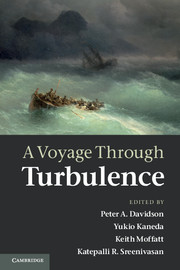Book contents
- Frontmatter
- Contents
- List of contributors
- Preface
- 1 Osborne Reynolds: a turbulent life
- 2 Prandtl and the Göttingen school
- 3 Theodore von Kármán
- 4 G.I. Taylor: the inspiration behind the Cambridge school
- 5 Lewis Fry Richardson
- 6 The Russian school
- 7 Stanley Corrsin
- 8 George Batchelor: the post-war renaissance of research in turbulence
- 9 A.A. Townsend
- 10 Robert H. Kraichnan
- 11 Satish Dhawan
- 12 Philip G. Saffman
- 13 Epilogue: a turbulence timeline
- References
9 - A.A. Townsend
Published online by Cambridge University Press: 07 October 2011
- Frontmatter
- Contents
- List of contributors
- Preface
- 1 Osborne Reynolds: a turbulent life
- 2 Prandtl and the Göttingen school
- 3 Theodore von Kármán
- 4 G.I. Taylor: the inspiration behind the Cambridge school
- 5 Lewis Fry Richardson
- 6 The Russian school
- 7 Stanley Corrsin
- 8 George Batchelor: the post-war renaissance of research in turbulence
- 9 A.A. Townsend
- 10 Robert H. Kraichnan
- 11 Satish Dhawan
- 12 Philip G. Saffman
- 13 Epilogue: a turbulence timeline
- References
Summary
Early years
Albert Alan Townsend was born on the 22nd of January 1917 in Melbourne Australia son of Albert Rinder Townsend and Daisy Townsend née Gay. At the time of his birth his father was a clerk in the accounts branch of the Department of Trade and Customs – he also served as secretary of the Commonwealth Film Censorship Board. His father went on to have a very successful career in the Commonwealth public service. As his career evolved he moved the family to Canberra in the ACT (Australian Capital Territory) which is the seat of the government in Australia. Albert and Daisy had three children: Alan, Elisabeth and Neil. In 1933 Albert Rinder Townsend was awarded the OBE.
Alan obtained his Leaving Certificate in 1933 from the Telopea Park High School with an outstanding pass, including first-class honours in mathematics, and the Canberra University College Council awarded him a scholarship of £120 a year to pursue a science course at Melbourne University. He completed his Bachelor of Science in 1936, graduating with first-class honours, and started his Master of Science. Just before his 20th birthday (1937) he graduated Master of Science, with honours in natural philosophy and pure mathematics. He was awarded the Dixson Research Scholarship and the Professor Kernot Research Scholarship.
- Type
- Chapter
- Information
- A Voyage Through Turbulence , pp. 305 - 328Publisher: Cambridge University PressPrint publication year: 2011



